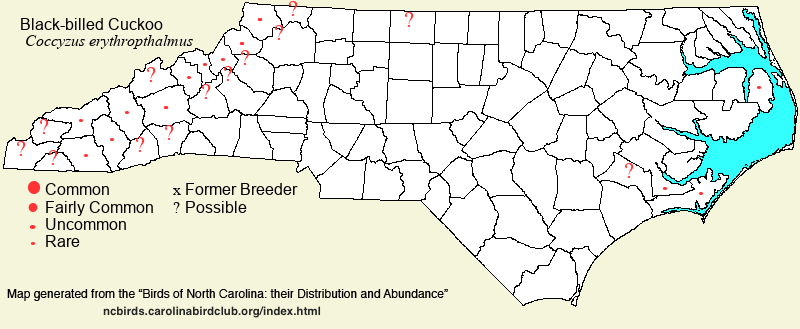 |  |
|
Black-billed Cuckoo - Coccyzus erythropthalmus CUCULIDAE Members: | Search Common: Search Scientific: |
|
|
|||||||
| General Comments | The Black-billed Cuckoo is one of the state's most unpredictable breeding species, and, because it is generally scarce in the East, it can be a very difficult species to "nail down" on a year list or on a specific trip to the breeding range. It is also scarce as a spring and fall migrant, and the average birder will not see a Black-billed Cuckoo in the state in a given year unless he or she is afield several times a week. The northbound flight is often quite late, and birds are sometimes found even in early Jun in places that seem unlikely as breeding sites (such as in swampy forests near the coast). Much is still to be learned about its breeding range in the state. The species favors mid- to high elevation hardwood forests in the state for breeding, even places where some conifers (such as spruce) are mixed with hardwoods. They also can be found breeding, at least sparingly, in groves of hardwoods along rivers and creeks in otherwise open country, in the mountains. The species winters south of the United States. | ||||||
| Breeding Status | Breeder | ||||||
| NC BRC List | Definitive | ||||||
| State Status | SR | ||||||
| U.S. Status | |||||||
| State Rank | S2B | ||||||
| Global Rank | G5 | ||||||
| Coastal Plain | Transient, and very sporadic breeder near the coast. Rare migrant along and near the coast, mainly early May to early Jun, and mid-Aug to mid-Oct, but with a number of records in Jun, Jul, and Aug; very rare to rare farther inland. Probably more "numerous" on the Outer Banks, but even there it is difficult to encounter. In recent years, small numbers have been regularly seen and heard singing, mostly in late May and early Jun, in places such as the Alligator River NWR and Croatan National Forest, suggestive of breeding. Finally, breeding was confirmed at two sites in the summer of 2012, when an adult was observed feeding a juvenile in Croatan National Forest, and fledglings were observed at Pocosin Lakes NWR [Chat 76:137 link]. Also unusual was a territorial pair (supposedly) in southwestern Halifax on 21 Jun 2009, and one bird was seen there on 9 Jul. There is one very old breeding record: a nest with eggs in Bertie on 19 May 1896. Peak counts: 8, Alligator River NWR, 25 May 1997; 6, Pea Island NWR, 27 Aug 1964. | ||||||
| Piedmont | Transient, and very sporadic breeder (now essentially casual). Rare migrant in both spring and fall across the entire region, mainly very late Apr to late May, and mid-Sep to mid-Oct; scattered records in Jun, Jul, and Aug. Has bred in Wake (prior to 1959). Two birds seen and heard calling at the Dan River Game Land (Rockingham) on 11 Jul 2020 were quite unusual and were possible breeders. Peak counts: 3, Jordan Lake, 9 May 1993. | ||||||
| Mountains | Summer resident, and transient. In summer, rare but sporadic, more "numerous" in some years than others, but seldom even uncommon. Nests mainly between 3,000 and 5,500 feet, somewhat more frequent above 4,000 feet. A good majority of summer records are from the Blue Ridge Parkway, perhaps because of ease of access to higher elevations of deciduous forests. Rare as a transient across the province. Mainly late Apr to mid-Oct; migrants mainly to early Jun, and by early Sep. A report from Yancey on 27 Dec (year not stated in Pearson et al., 1959) needs confirmation, as the species is practically never seen in the United States in this month. Peak counts: 6, Maggie Valley (Haywood), 3 Sep 1994; 5, Piney Creek (Alleghany), 10 Aug 2008; 4, Rough Butt Bald (Blue Ridge Parkway), 1 Jun and 25 Jun 1990. | ||||||
| Finding Tips |
This can be a difficult bird to find in NC, even though a small population is present in the mountains each summer. Adults are not particularly vocal. Sometimes, birds are more vocal in Jul or Aug than in May or Jun. Your best bet is to bird hardwood forests above 4,000 feet. The Blue Ridge Parkway, from the junction of Heintooga Road southeast to the Devils Courthouse area, is the best area in the state. Make many stops, and hike around a bit if needed. Grandfather Mountain, Big Yellow Mountain, and other high elevation mountains have a few birds during most summers. However, more than likely you will not find one by intentionally searching for them! * to ** | ||||||
| Attribution | LeGrand[2023-03-03], LeGrand[2020-10-20], LeGrand[2013-12-11] | ||||||
| NC Map Map depicts all counties with a report (transient or resident) for the species. | Click on county for list of all known species. |
| NC Breeding Season Map Map depicts assumed breeding season abundance for the species. |  |